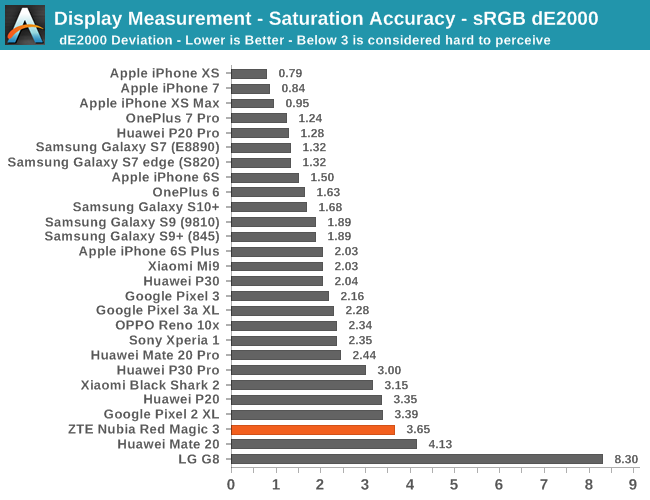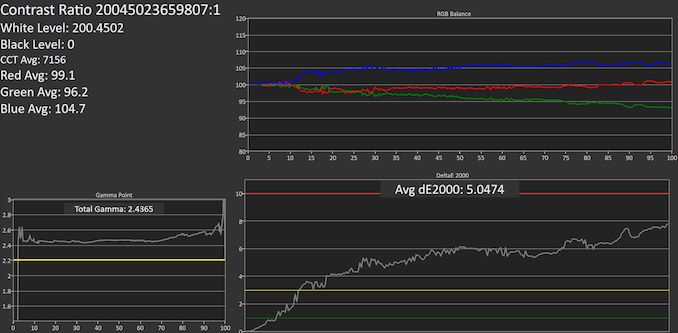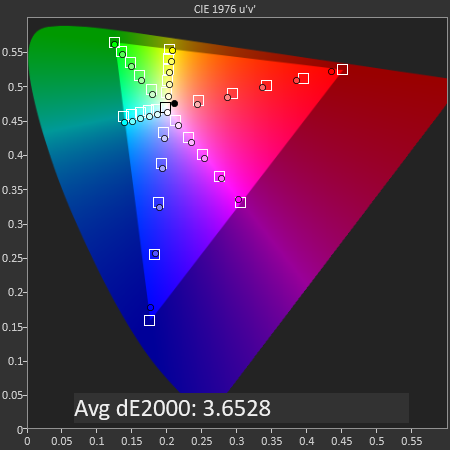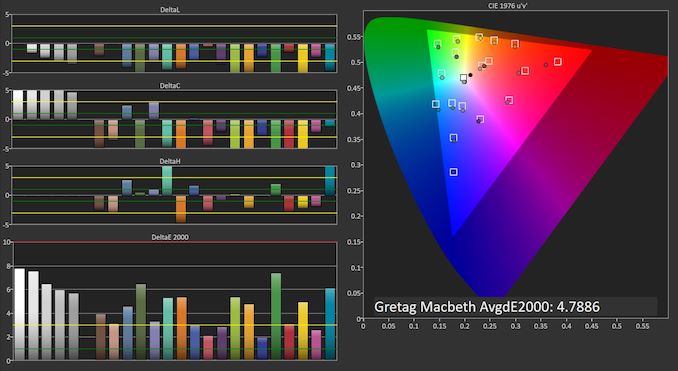The Nubia Red Magic 3 Review: A 90Hz Gaming Phone With Active Cooling
by Andrei Frumusanu on September 27, 2019 9:00 AM EST- Posted in
- Mobile
- Smartphones
- ZTE
- Nubia
- Snapdragon 855
- Nubia RedMagic 3
Display Measurement
The Red Magic 3 features a 2340 x 1080 6.65” OLED screen. At this screen size, the resolution is certainly quite stretched, however for a gaming phone I don’t think that’s too much of a priority, and the 90Hz refresh of the panel certainly makes up for it.
The phone’s software settings are very basic, there’s just a toggle between a Display P3 gamut target and an sRGB target.
We move on to the display calibration and fundamental display measurements of the Red Magic 3 screen. As always, we thank X-Rite and SpecraCal, as our measurements are performed with an X-Rite i1Pro 2 spectrophotometer, with the exception of black levels which are measured with an i1Display Pro colorimeter. Data is collected and examined using SpectraCal's CalMAN software.

In terms of maximum brightness, the phone gets an unusual maximum of 455 nits, which is slightly above the regular ~400 of “standard” OLED panels out there in the market. It doesn’t get as bright as newer panel generations and it also lacks a brightness boost function.
In terms of greyscale accuracy, the RM3 exhibits quite a colder colour temperature at 7156K. There’s no way to change this in the settings and is essentially what you’re stick with.
I also note that the gamma for the phone is very high and looks like it’s targeting a level of 2.5, coming in close at 2.43.
There’s a noticeable blue-shift as well as darker tones in the greyscale reproduction.

Because of these large divergences, the phone only ends up with a dE2000 of 5.04, among one of the worst results out there.
In the sRGB saturations test, the RM3 actually seems to do quite well and it’s saturation levels aren’t too bad and it keeps largely to the gamut, albeit the maximum reds and blues are short of the full sRGB gamut. The main issue here is that everything is shifted by the off-target colour temperature.

Mainly due to the colour temperature shift, we see the phone only end up with a dE2000 of 3.65 in the sRGB natural setting.
In the P3 higher gamut mode, the phone’s saturations actually seem to exceed the standard. The higher mid-level saturations are also due to the higher than 2.2 gamma target employed by the Nubia.

Due to the colour temperature shift again and the gamma not being on target, the RM3 only manages a dE2000 of 3.88.

The GMB test isn’t too terrible, but again, colour temperature and gamma are the biggest issues in the inaccuracies.
Overall, the RM3’s colour calibration isn’t too fantastic simply due to the fact that it’s knowingly targeting something different from the norm. The colour temperature shift unfortunately isn’t something you can fix as there’s no dedicated controls for it – and the higher gamma target of 2.5 is also that’s inherent to the vendor’s choice.
While the colour calibration is certainly not par with other flagships, it remains a good screen due to the OLED aspect and simply due to the fact that it’s a 90Hz display.
















31 Comments
View All Comments
stephenbrooks - Friday, September 27, 2019 - link
The irony I've noticed is the higher-end the phone (or laptop) is, the faster the battery seems to drain. Presumably because of high-spec components.oRAirwolf - Saturday, September 28, 2019 - link
https://en.wikipedia.org/wiki/Project_AraEj24 - Friday, September 27, 2019 - link
https://en.wikipedia.org/wiki/Project_Aradidn't pan out
webdoctors - Friday, September 27, 2019 - link
The future is streaming, even consoles in the living room are headed towards cloud streaming. With 5G and wifi everywhere on the horizon, its nuts to try to lug a highend SoC into the mobile arena.If an Nvidia Shield TV with 3 GB RAM can do streaming no reason you need such a high end SoC for a streaming gaming phone. They could build a proper streaming gaming phone and have it with much better battery life and lower cost.
peevee - Friday, September 27, 2019 - link
Streaming sucks, streaming over wireless sucks more (hint: large and unpredictable latency).peevee - Friday, September 27, 2019 - link
Plus of course ongoing subscription costs.abufrejoval - Friday, September 27, 2019 - link
Streaming doesn't have to be from the cloud: Your gaming desktop in the next room might do just as well.I use that for kid's LAN parties, where I put notebooks on the dinnertable to avoid lugging the gaming towers to the "hot spot".
And yes, cables, even 100Mbit/s, beat WiFi any time of the day even for local streaming (e.g. Steam remote play).
Of course, a certain degree of masochism is required to game on a phone when you can have a proper screen (or simply younger eyes).
PeachNCream - Friday, September 27, 2019 - link
I used to do quite a bit of streaming via Steam from a desktop PC that I had running headless and crammed into a corner near my cheap ISP router. It was wired at 100mbit. The other end was an Atom n450 netbook running Linux on WiFi and its NIC topped out at 54mbit. It was pretty good for stuff like Fallout 3 and Skyrim. Latency was decent even when there was other usage of the local network for things like Youtube streaming or web surfing (the gaming desktop was the only thing not on wireless so phones and other laptops were being used by family members). I wouldn't want to play a twitchy shooter type thing over it, but for pretty much anything else it worked really well. I think in the intervening three or so years, things have probably gotten better but I can't test that since I no longer have a gaming PC, just some casual stuff that runs natively under Linux on my laptops. I haven't even had Steam installed in the last couple of years since entertainment is slowly shifting over to my phone these days. There just isn't much need for PC gaming or streaming between PCs.FunBunny2 - Sunday, September 29, 2019 - link
"With 5G and wifi everywhere on the horizon"Real 5G???? outside of sports stadiums, not going to happen. hell, it can't even get into a stick built house. you'll need a rooftop antenna to capture the signal. just watch.
"Verizon uses a window or roof-mounted 28GHz antenna to grab the 5G signal, which is distributed via WiFi from a home router indoors."
here: https://www.lightreading.com/mobile/5g/verizons-fi...
IOW, Real 5G ends up being little different from phone pole fiber.
peevee - Friday, September 27, 2019 - link
You have missed the most important spec of a mobile phone - wireless protocols/frequencies supported.It is not an iPod after all.